The 50th edition of the Top500 list, the biannual publication of the world’s fastest supercomputers based on public Linpack benchmarking results, was released from SC17 in Denver, Colorado, this morning and once again China is in the spotlight, having taken what is on the surface at least a definitive lead in multiple dimensions. China now claims the most systems, biggest flops share and the number one machine for 10 consecutive lists. It’s a coup-level achievement to pull off in five years, disrupting 20 years of US dominance on the Top500, but reading deeper into the Top500 tea leaves reveals a more nuanced analysis that has as much to do with China’s benchmarking chops as it does its supercomputing flops.
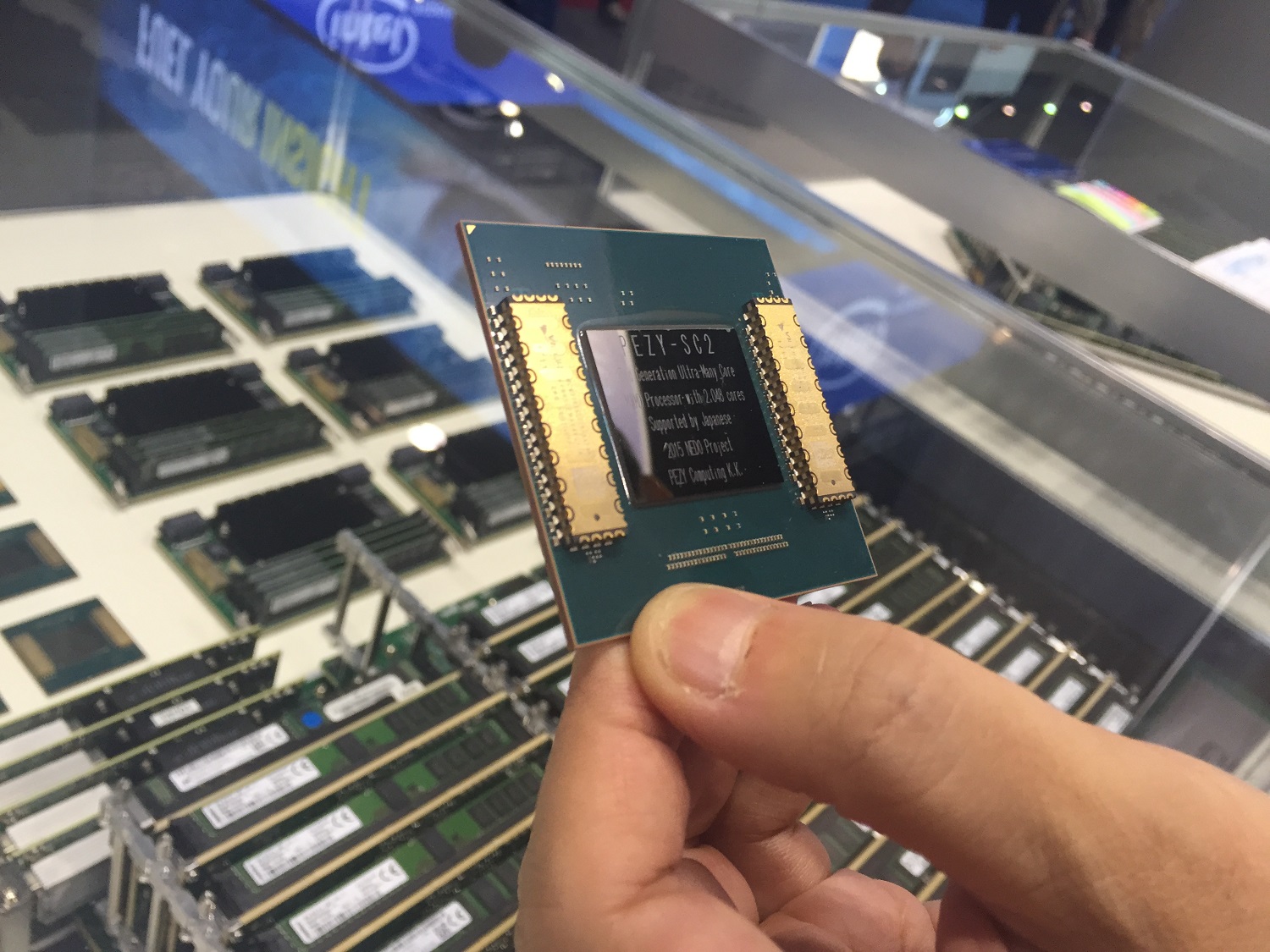
Before we thread that needle, let’s take a moment to review the movement at the top of the list. There are no new list entrants in the top ten and no change in the top three, but the upgraded ZettaScaler-2.2 “Gyoukou” stuck its landing for a fourth place ranking. Vaulting 65 spots, the supersized Gyoukou combines Xeons and PEZY-SC2 accelerators to achieve 19.14 petaflops, up from 1.68 petaflops on the previous list. The Top500 authors point out that the system’s 19,860,000 cores represent the highest level of concurrency ever recorded on the Top500 rankings.
Gyoukou also had the honor of being the fifth greenest supercomputer. Fellow ZettaScaler systems Shoubu system B, Suiren2 and Sakura, placed first, second and third respectively (see perf-per-watt numbers below). Nvidia’s DGX SaturnV Volta system, installed at Nvidia headquarters in San Jose, Calif., was the fourth greenest supercomputer.

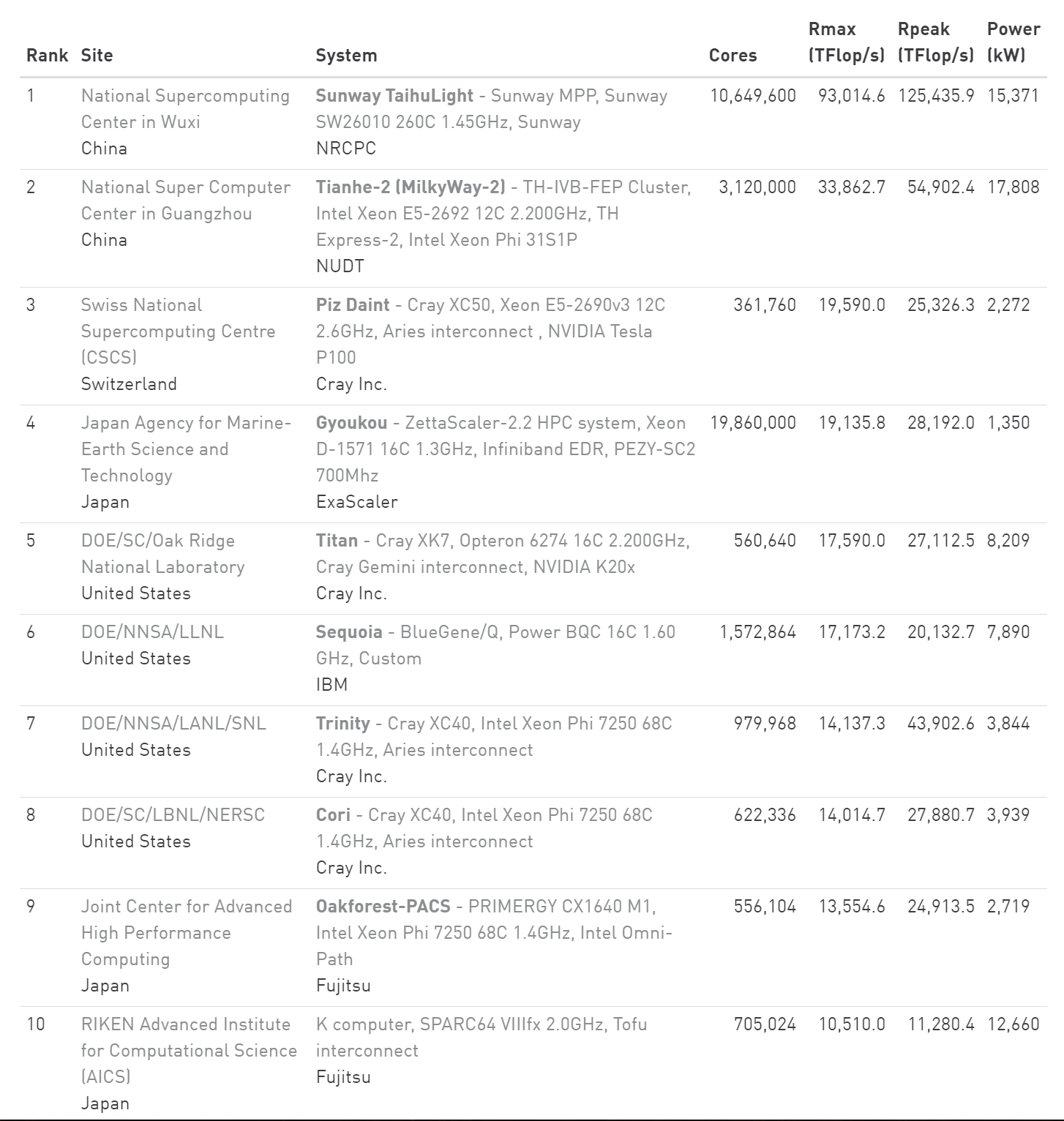
Another upgraded machine, Trinity, moved up three positions to seventh place thanks to a recent infusion of Intel Knights Landing Xeon Phi processors that raised its Linpack score from 8.10 petaflops to 14.14 petaflops. Trinity is a Cray XC40 supercomputer operated by Los Alamos National Laboratory and Sandia National Laboratories.
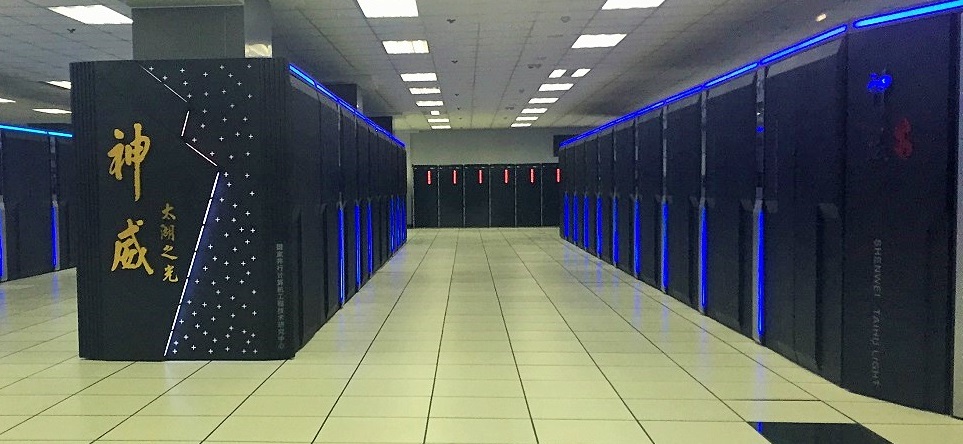
China still has a firm grip on the top of the list with 93-petaflops Sunway TaihuLight and 33.86-petaflops Tianhe-2, the number one and and two systems respectively, which together provide the new list with 15 percent of its flops. Piz Daint, the Cray XC50 system installed at the Swiss National Supercomputing Centre (CSCS) remains the third fastest system with 19.6 petaflops. With Gyoukou in fourth position, the fastest US system, Titan, slips another notch to fifth place, leaving the United States without a claim to any of the top four rankings. Benchmarked at 17.59 petaflops, the five-year-old Cray XK7 system installed at the Department of Energy’s Oak Ridge National Laboratory, captured the top spot for one list iteration before being knocked off its perch in June 2013 by China’s Tianhe-2. This is the first time in the list’s 24-year history that the US has not held at least a number four ranking.
Although China has enjoyed number one bragging rights for nearly four years, this is the first list that it also dominates by both system number and aggregate performance share as well. China has the most installed systems: 202 compared to 159 on the last list, while US is in second place with 144 down from 169 six month ago (Japan ranks third place with 35, followed by Germany with 20, France with 18, and the UK with 15.). Aggregate performance is similar: China holds 35.3 percent of list flops, and the US is second with 29.8 percent (then Japan with 10.8 percent, Germany with 4.5 percent, UK with 3.8 percent and France with 3.6 percent).
Based on these metrics, undoubtedly some publications will proclaim China’s supercomputing supremacy, but that would be premature. When China expanded its Top500 toehold by a factor of three at SC15, Intersect360 Research CEO Addison Snell remarked that it wasn’t so much that China discovered supercomputing as it discovered the Top500 list. This observation continues to hold water.
An examination of the new systems China is adding to the list indicates concerted efforts by Chinese vendors Inspur, Lenovo, Sugon and more recently Huawei to benchmark loosely coupled Web/cloud systems that strain the definition of HPC. To wit, 68 out of the 96 systems that China introduced onto the latest list utilize 10G networking and none are deployed at research sites. The benchmarking of Internet and telecom systems for Top500 glory is not new. You can see similar fingerprints on the list (current and historical) from HPE and IBM, but China has doubled down. For comparison’s sake, the US put 19 new systems on the list and eight of those rely on 10G networking.
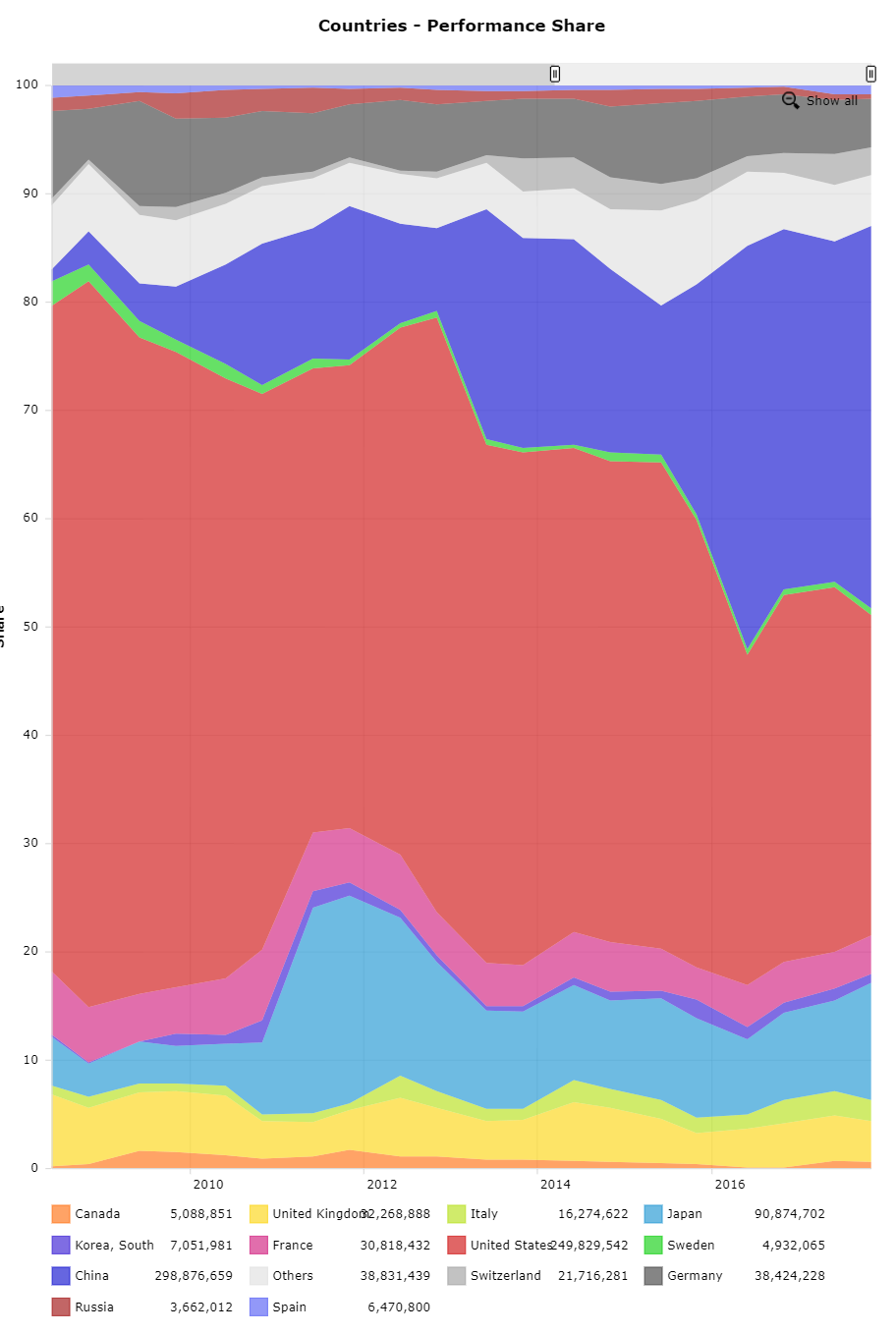
Not only has the Linpacking of non-HPC systems inflated China’s list presence, it’s changed the networking demographics as the number of Ethernet-based machines climbs steadily. As the Top500 authors note, Gigabit Ethernet now connects 228 systems with 204 systems using 10G interfaces. InfiniBand technology is now found on 163 systems, down from 178 systems six months ago, and is the second most-used internal system interconnect technology.
Snell provided additional perspective: “What we’re seeing is a concerted effort to list systems in China, particularly from China-based system vendors. The submission rules allow for what is essentially benchmarking by proxy. If Linpack is run and verified on one system, the result can be assumed for other systems of the same (or greater) configuration, so it’s possible to put together concerted efforts to list more systems, whether out of a desire to show apparent market share, or simply for national pride.”
Discussions of list purity and benchmarking by proxy aside, the High Performance Linpack or any one-dimensional metric has limited usefulness across today’s broad mix of HPC applications. This truth, well understood in HPC circles, is not always appreciated outside the community or among government stakeholders who want “something to show” for public investment.
“Actual system effectiveness is getting more difficult to compare, as the industry swings back toward specialized hardware,” Snell commented. “Just because one architecture outperforms another on one benchmark doesn’t make it the best choice for all workloads. This is particularly challenging for mixed-workload research environments trying to serve multiple domains. 88 percent of all HPC users say they will need to support multiple architectures for the next few years, running applications on the most appropriate systems for their requirements.”
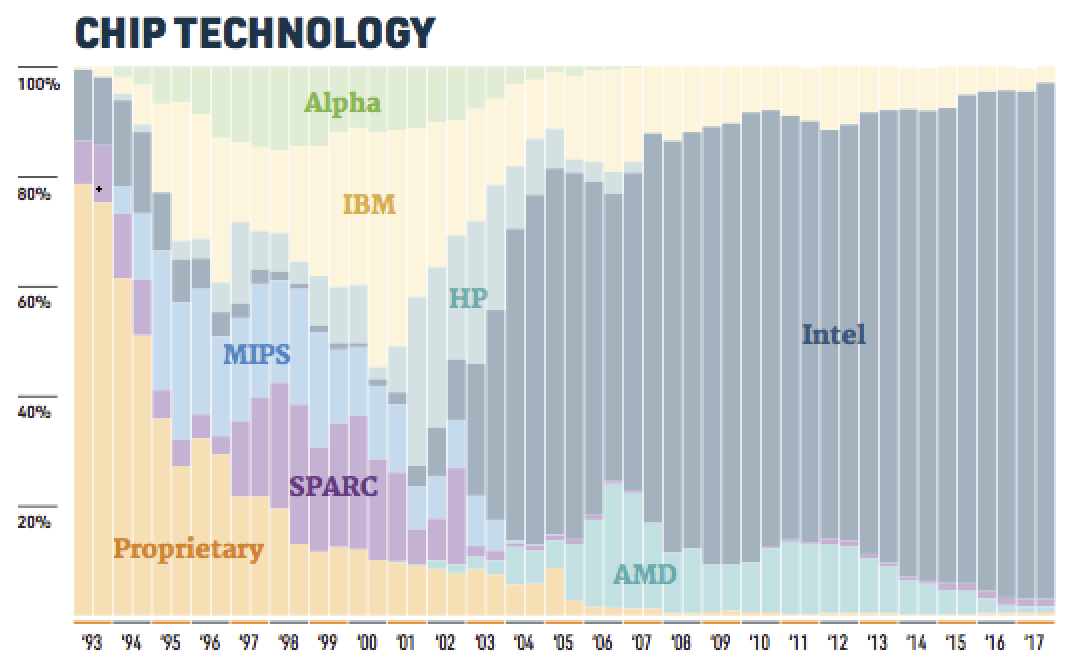
There has been stagnation on the list for several iterations and turnover is historically low. Neither Summit or Sierra (the US CORAL machines, projected to achieve 150-200 petaflops) nor the upgraded Tianhe-2A (projected 94.97 petaflops peak) made the cut for the 50th list as had been speculated. While HPC is seeing a time of increased architectural diversity at the system and processor level, the current list is less diverse by some measures. To wit, of the 136 new systems on the list, Intel is foundational to all of them (36 of these utilize accelerators*). So no new Power, no new AMD (it’s still early for EPYC) and nothing from ARM yet. In total 471 systems, or 94.2 percent, are now using Intel processors, up a notch from 92.8 percent six months ago. The share of IBM Power processors is at 14 systems, down from 21 systems in June. There are five AMD-based systems remaining on the list, down from seven one year ago.

In the US, IBM Power9 systems Summit and Sierra are on track for 2018 installation at Oak Ridge and Livermore labs (respectively), and multiple other exascale-focused systems are in play in China, Europe and Japan, showcasing a new wave of architectural diversity. We expect there will be more exciting supercomputing trends to report on from ISC 2017 in Frankfurt.
*Breakdown of the 36 new accelerated systems: 29 have P100s (one with NVLink, an HPE SGI system at number 292 (Japan)), one internal Nvidia V100 Volta system (#149, SaturnV Volta); one K80-based system (#267, Lenovo); two Sugon-built P40 systems (#161, #300), and three PEZY systems (#260, #277, #308). Further, out of the 36, only the internal Nvidia machine is US-based. 30 are Chinese (by Lenovo, Inspur, Sugon); the remaining five are Japanese (by NTT, HPE, PEZY).





























































